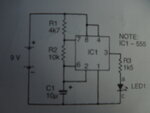Resistanceisfutile
Member level 4
I'm using the 555 to generate square waves.
A 4 Hz wave is fine, but when I generate 4 kHz wave I get virtually nothing out of the output pin (I get about 0.04 v). Does this mean my 555 timer is broken, or do I need to increase power supply/use a transistor? (I'm powering it with a 9V battery).
A 4 Hz wave is fine, but when I generate 4 kHz wave I get virtually nothing out of the output pin (I get about 0.04 v). Does this mean my 555 timer is broken, or do I need to increase power supply/use a transistor? (I'm powering it with a 9V battery).

